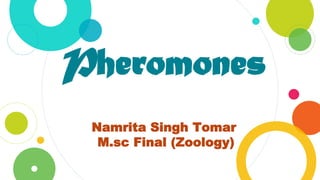
Pheremones by Namrata Singh Tomar M.Sc. I year.pptx
- 1. Pheromones Namrita Singh Tomar M.sc Final (Zoology)
- 2. Introduction Pheromones (chemical communication) is a chemical that is produced & released into the environment by one organism and affect the behavior of another organism of the same species. Karlson & Luscher (1959) coined the term ‘pheromones’. They are used as chemo signals in intraspecific communication . Pheromones are also called ectohormone & release in minute quantity. 2
- 3. Discovery ◎ In the 18th century, the discovery of pheromones took place by chance. A French biologist, Bonnet, discovered the long trail of ants. Bonnet placed a colony of ants at one end of a table and a small heap of sugar at the other end. ◎ He observed that the ants coming out of the colony moved across the table to the pile, picking up sugar and moving back to the colony with it. The ants moved to and fro along a definite track, with none diverting from it Bonnet wanted to know why the ants followed such a definite trail and so he broke the continuity of this path by rubbing his finger across the line of the ants. The ants stopped and searched about at the rubbed area. 3
- 4. Bruce had recognized 3 types of Pheromones 1) Releaser pheromones These are also know as signalling pheromones. It stimulate the CNS of recepient an immediate change in its behaviour. Releaser pheromones in mammals are present in the urine and footpads. Urine of male mice, deer, dog, horses etc. contains releaser pheromones for attracting females. Types of Pheromones 4
- 5. 2)The Primer Pheromones They evoke a prolonged or long term endocrine or physiological responses in receivers mediated by the direct effects on the target organs. For example In ants, termites and honey bees, members of the same colony share a common pheromone which differs from that of the other colonies of the same species. 3)Imprinting pheromones They act at critical period of developmental age and cause permanent change in the adult behaviour. For example mice and rats. 5
- 6. * These are derivatives from protein & fatty acide. * These are volatile in nature. * These are species specific their effect depend on cone and distance between the orgnism. * These are secreted by endocrine gland. 6 Character of Pheromones Difference Between Hormones & Pheromones i. These are released by endocrine gland and transmitted externally. ii. These are species specific and produce specific developmental response in the bodies of other members of the same species.
- 7. Mode of Action ◎ By Olfaction Insect-Insect & mammals both example sex attacked. ◎ By Physical contact –Adult male locust release .Pheromones that comes in contact which means that induces growth & metamorphosis in it nymph. 7
- 8. Pheromones in Animals: 1. Pheromones in Invertebrates: The males of Lepidoptera (butterflies and moths) produce scent from glands known as androconial which are located in wings associated with scales. Androconial have a somewhat elongated structure and terminates in a row of fine processes called fimbriae. 8
- 9. 9 Production and Perceptions Glands producing pheromones Pheromones are produced by definite glands. The location & structure of these glands on the body varies in different animals. The insects have been most extensively studied for their pheromones and structures related to their production and perception. Honey bee have 2 main gland which produce pheromones 1) Mandibular glands are located in the head region. 2) Nassanoff’s gland or Wax gland in the abdomen . These glands are well developed in the queen and worker’s , but generally reduced in the drones.
- 10. 10 ◎ Silk moth produced Bombykol ◎ Bee produced Honey bee queen substance ◎ Gypsy moth produce Gyplure ◎ Musk deer produced Muscone ◎ Civet produced civetone
- 11. ◎ 2. Pheromones in Vertebrates: Many vertebrate produce colour scent or pheromones to carry out many important function . House shrew, striped hyena and black tailed deer produced scent under stress. The scent is released in many ways along with urine, faeces and saliva, they are also produced through special glands. 11 Markings with urine and faeces: A. Many mammals communicate through pheromones present in urine and/or faeces. B. These are used to scent mark a core area, home range or territory. C. Some animals also use urine and faeces to mark pathways, resting grounds, feeding grounds and sleeping sites. It is also used to mark rivals, opponents, defeated animals etc.
- 12. 12 Functions of Pheromones: A. Sex attractants: Female insects usually releases pheromones by exposing the glands by movement of abdomen. Generally they are released at particular time of the day, depending upon the diurnal or nocturnal nature of the animal. The scent thus released excite the approaching male and serves as a guide for reaching the female. A. Pheromones of males: these are present in very few instances such as male protruding sex attractant . This is tree of the make beetle Harpobitiacus. B. Communication in social insects: In case of fire ants, pheromones play a role in communication. The worker, after discovering a food source, returns back to the nest by laying a trail. C. Maintenance of social structure: The queen bee produces pheromones which help in controlling the social structure of her colony.
- 13. ◎ Adverse Effects of Pheromones: ◎ Pheromones sometimes have certain adverse effect on the user: ◎ 1. The pheromones produced by Anagasta larva induce the parasite, Venturia, to make probing movement with its ovipositor. This increases the larva getting parasitized. 13
- 14. 14 ◎ 2. Pheromones sometimes advertise the presence of an insect predator and potential parasite. The clerid beetle (Thanasimus dubius) is a predator of Dendroctonus (beetle). It thus is able to locate its host by responding to the pheromones frontalin secreted by the host.
- 15. Thanks! 15